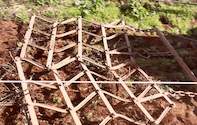Tillage is the mechanical agitation of the soil in a vineyard and is usually associated with the loosening and overturning of the soil. It ensures a clean surface around the rootstocks and eliminates weeds.

After tillage, manure and compost are incorporated into the soil. However, over the years there has been a move to minimum tillage. Soil management must be carefully planned to prevent the soil structure from being destroyed. The following are some of the reasons for tillage of a vineyard after it has been established. The removal of weeds and hence the elimination of weed competition: actively growing weeds use the available water and nutrients intended for the vineyard.
The root system of most weeds grows about 15 to 40 cm deep; the same depth where most of the feeder roots are found in the vineyard. To loosen the soil where other cultivation actions have hardened the soil: regulated tractor movement can harden the soil and thus reduce root growth.
Tillage loosens the soil so that effective air movement can take place. Groundwater conservation: water does not evaporate easily from a loose surface and tillage increases water penetration during irrigation and rain.
Tillage prepares a seedbed for the sowing of cover crops. Tillage aerates the soil: weeds, cover crops, compost and fertilizer are incorporated to be nutrition for the plants. It is further broken down by soil microbes to form humus (a form of mature compost). Improved air movement in the vineyard: long or thick weeds restrict the air movement between the vines. This can cause the vine leaves to stay wet longer and thus promote fungal diseases.
By Vinpro